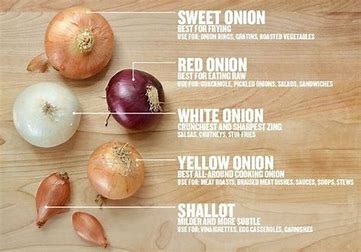Are You Cooking With the Best Type of Onion? Probably Not.
All onions are not created equal — which is why it’s frustrating when a recipe calls for “an onion.� Sure, it’s not the end of the world if you use a red onion when the recipe writer had a yellow one in mind, or vice versa, since pretty much every onion will cook the same way. But using the best onion for the job can really add a depth of flavor to your meals that using a sub-par type just...well, won’t.
Ingredients:
Directions:
RED ONIONS (PURPLE):
For most of the year, you’ll find red storage onions at the supermarket, which are pungent and spicy. In the summer months, you’ll often find fresh red onions, which are much more mild, and lack a bit of the “onion-y� flavor you’ll find in their yellow and white cousins. They do much better raw than cooked. If you find the taste of raw red onions (and really any other type of onion) too sharp, you can soak red onions in water for 30 minutes-1 hour.
Best For: Salads, sandwiches, burgers, pickling, salsas.
YELLOW ONIONS:
The gold standard onion and usually the cheapest one at the market. If you’re using a recipe that doesn’t specify what type of onion to use, a yellow onion is your best bet. Yellow onions are particularly hardy, and their flavor complex and spicy. They also have more sulfur than other onion varietals, so they’re much more pungent, difficult to eat raw, and more likely to make you tear up. Yellow onions keep for a very long time.
Best For: Dishes that cook for a long time on low heat, like soups, including French onion soup, stocks, risotto, sauces and stews. Anything sautéed, too.
WHITE ONIONS:
Of all of the main types of onion, white onions are the least common. Sharper than yellow onions, crisp and clean white onions are great raw and cooked. You can cook white onions like you would yellow onions. White onions have a slightly shorter storage life than yellow onions, but should not be kept in the fridge.
Best For: Mexican food, white sauces, pasta salads, raw in salads, in chili, and potato salads.
SWEET ONIONS:
They tend to be larger, and have thinner skin, than other types of onions. Some are so sweet that you can actually eat them like an apple. You may have seen sweet onions called Vidalia, Walla Walla, and, less commonly, Texas sweet onions and Maui onions. Sweet onions are much less pungent, and yes, sweeter, than yellow onions. They break down quickly and aren’t very complex, so it’s best not to use them in lieu of regular yellow onions as an aromatic flavor. Unlike other onions, sweet onions spoil quickly and should be stored in the fridge.
Best For: Gratins, roasted vegetables, onion rings. They’re also great raw on salads and sandwiches. My favorite? On the grill with a little olive oil, salt and pepper!
Cook'n is a next generation recipe app that makes it fun and easy to share favorite recipes.
Click here to get Cook'n (it's free!)
Cook'n is a next generation recipe app that makes it fun and easy to share favorite recipes.
